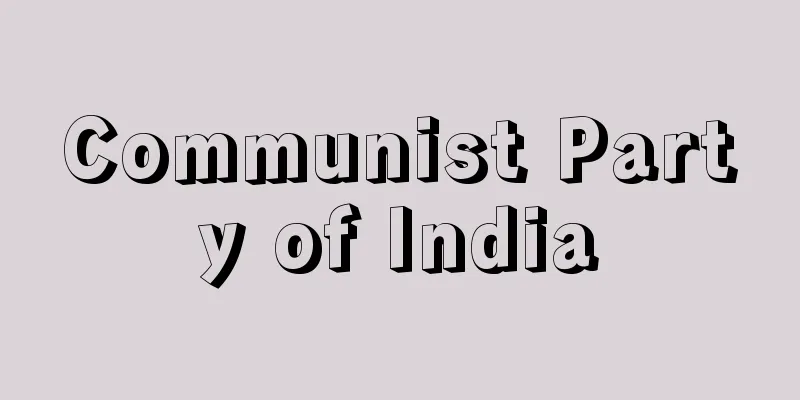Communist Party of India

|
Communist Party of India, founded in 1920. Abbreviated as CPI. The Communist Party of India was founded in October 1920 in Tashkent, Soviet Union (now Uzbekistan), just after the First World War, by Indian revolutionaries in exile, led by M. N. Roy (from Bengal), who had attended the Second Congress of Comintern. Domestically, it was launched in December 1925 in the industrial city of Kanpur, North India, with S. V. Ghate as its general secretary. The Communist Party gradually expanded its organizational influence through the Indian National Congress (founded in 1885), which was based on the urban middle class and the general public, the All India Trade Union Congress (founded in 1920), and the All India Peasant Union (founded in 1936). All of these were targets of oppression by the British, but the Indian people's movement for independence was generally tenacious, and the Communist Party's influence steadily grew. During World War II, the outbreak of the German-Soviet War marked the transition from an imperialist war to an anti-fascist people's war, and the Communist Party of India was legalized. From 1943, on the eve of independence, to the following year, the Bengal famine occurred, leaving 3.5 million people starving to death, but through relief efforts the Communist Party finally secured the status of a mass political party. Furthermore, in 1946, peasant movements arose in both Telangana in southern India and Bengal in eastern India, shaking British rule to its very foundations. In the case of Bengal, the majority of poor peasants and farm labourers launched the Thebaga movement, demanding two-thirds of the harvest from the landlords known as Jothedars. On August 15, 1947, India, having escaped from British rule, chose the path to becoming an Indian-style democratic state, that is, a federal republic with sovereignty of the people, under the leadership of Prime Minister J. Nehru and the Indian National Congress. The Communist Party of India held its second party conference in early 1948, claiming that India's independence was a false independence and that imperialism had shifted from direct rule to indirect rule, and adopted a far-left line that endorsed armed struggle. After that, while the party adopted an anti-China stance in the Sino-Indian border war and supported the Congress government, ideological struggles within the party intensified. At the 7th party conference held in October-November 1964, the Communist Party of India (Marxist) was launched, which placed importance on the internal and external activities of the parliament in the federal and state governments, and advocated anti-feudalism, anti-imperialists, and anti-monopoly policies, while the Communist Party of India split off into two factions, one of which was based solely on the struggle for parliamentary democracy. E. M. S. Namboodirippad (from Kerala) was appointed secretary-general of the former. The party's journal was People's Democracy, and its affiliates included the All India Farmers Union and the newly organized Indian Trade Union Centre, and in 1981 the All India Democratic Women's Federation was launched. In addition to these two parties, there have been various forces calling themselves Maoists that have been focusing on armed struggle since the late 1960s. As early as the late 1950s, a communist government was briefly established in the southern Indian state of Kerala. As a result of the West Bengal state assembly elections in June 1977, Jyoti Basu (1914-2010, from Bengal) formed a coalition government that included the Forward Bloc under the Communist Party of India (Marxist). This new government was called the Left Front Government (LFG), and Basu himself served as the state's chief minister for 23 years until his retirement in 2000. Since then, B. Bhattacharjee of the same party has taken over as chief minister. The achievements of this state government can be summarized in the following four points. (1) The distribution of 526,500 hectares of land to the poor and farm laborers and the distribution of land deeds guaranteeing the cultivation rights of farmers, including women; (2) The introduction of a democratic three-tier local government system (panchayati raj) spanning village, upazila and district levels, and in 2010, approval of an increase in the quota for female council members to 50%; (3) The construction of certain new industrial sectors and increased employment opportunities in response to the federal government's indifference to the requests of new state companies; (4) The resolution of ethnic issues such as Gorkhaland autonomy (demand for autonomy by a group of Nepali Indians in West Bengal), the coexistence of different religions and cultures, and the strengthening of separatism of religion and state. With independence, the federal government established the premise for developing an Indian-style democracy that leveraged relationships of coexistence and symbiosis with state governments. After the Nehru era came to an end in the late 1960s, as Prime Minister Indira Gandhi was succeeded by Prime Minister Rajiv Gandhi, the Congress government shifted from the planned economy of the early days of independence to neoliberal economic policies such as market liberalization. During this time, the federal government adopted discriminatory policies toward opposition state governments, and was even "hostile" to the industrialization plan proposed by the Left Front state government of West Bengal. As a result, the problem of eliminating the significant inter-state disparities in India became serious. Naturally, the need to eliminate centralism and reaffirm the fundamental principle of equal development of state autonomy has become a key issue in modern India. [Heiji Nakamura] [References] | | |Source: Shogakukan Encyclopedia Nipponica About Encyclopedia Nipponica Information | Legend |
|
1920年創設のインドの共産党。略称CPI。 インド共産党は、第一次世界大戦直後の1920年10月にソ連のタシケント(現ウズベキスタン)で、コミンテルン第2回大会に出席したM・N・ローイ(ベンガル出身)を中心とする、亡命中のインド人革命家たちによって結成された。国内では1925年12月に、北インドの工業都市カーンプルでS・V・ガーテーを書記長として発足した。共産党は都市の中間層や一般大衆を基盤にするインド国民会議派(1885年創立)をはじめ、全インド労働組合会議(1920年創立)や全インド農民組合(1936年創立)を通じて、組織勢力をしだいに拡大していった。それらはいずれもイギリスによって弾圧の対象にされたが、総じてインド民衆による独立要求の運動には粘り強いものがあり、共産党勢力は確実に発展していった。 第二次世界大戦期、独ソ戦の開始を機に、帝国主義戦争が反ファシスト人民戦争に転化する状況のもとで、インド共産党は合法化された。独立前夜の1943年から翌年にかけて、350万人の餓死者を出すベンガル飢饉(ききん)が発生したが、この救済活動を通じて、共産党は大衆政党の地位をようやく手にした。さらに1946年、南インドのテランガーナーと東部インドのベンガルの両地方で提起された農民運動は、イギリス支配を根底から揺さぶる事態をもたらした。ベンガル地方の場合、ジョテーダールとよばれる地主勢力に対して、大多数の貧農と雇農層は収穫物の3分の2を要求するテーバガ運動を提起した。 1947年8月15日、イギリス支配を脱したインドは、連邦首相J・ネルーと国民会議派の指導のもとで、インド型民主主義国家つまり主権在民の連邦制共和国への道を選択した。インド共産党は1948年初めに第2回党大会を開き、インドの独立は偽の独立であり、帝国主義は直接支配から間接支配へ変化したと主張し、武装闘争を是認する極左路線を採択した。 その後、中印国境戦争をめぐる反中国路線と、国民会議派政権支持を打ち出す一方で、党内のイデオロギー闘争が一段と激化した。1964年10月~11月の第7回党大会で、連邦・州における議会の内外活動を重視し、反封建・反帝国主義と反独占を掲げるインド共産党(マルクス主義者)が旗揚げする一方で、議会制民主主義の闘争だけに依拠するインド共産党と分裂した。前者の書記長にはE・M・S・ナンブーディリーパード(ケララ出身)が就任した。同党の機関誌は『人民民主主義』で、傘下には全インド農民組合や新組織のインド労働組合センターが並び、1981年には全インド民主主義女性連合が発足した。なお両党とは別に1960年代末から武装闘争中心の毛沢東派を名のる諸勢力が存在している。 すでに1950年代末、南インドのケララ州では一時期共産党の政権が誕生した。1977年6月、西ベンガル州の議会選挙の結果、インド共産党(マルクス主義者)のもとで、ジョティ・バス州首相(1914―2010、ベンガル出身)は、フォワード・ブロック(前進同盟)を含む連立内閣を発足させた。この新政府は左翼戦線州政府(LFG、Left Front Government)とよばれており、バス自身は2000年に引退するまで、実に23年間州首相の職にあった。以後同党のB・バッタチャールジーが州首相を継承している。この州政府の功績は以下の4点に集約されている。(1)52万6500ヘクタールの土地の貧・雇農層への分配と、女性を含む農民の耕作権を保障する土地証書の配布、(2)村、郡と県にまたがる民主的な三層地方自治制度(パンチャーヤティー・ラージ)の導入と、2010年にそれらの女性議員枠の50%への引上げ承認、(3)州新企業の要請に冷淡な連邦政府に対抗して、一定の新規工業部門の建設と雇用機会の増大、(4)ゴルカーランド自治(西ベンガル州のネパール系インド人集団による自治要求)など民族問題の打開、異宗教・異文化の共存と政教分離主義の強化にある。 独立を機に、連邦政府は各州政府との共存・共生関係を梃子(てこ)とするインド型民主主義を発展させる前提を確立した。1960年代末、ネルー時代が終わりを告げた後、インディラ・ガンディー首相からラジブ・ガンディー首相へ時代が進むなかで、国民会議派政権は、独立初期の計画経済を市場開放など新自由主義経済政策へ転換してきた。その間、連邦政府は野党州政府に対して差別政策をとり、たとえば西ベンガルの左翼戦線州政府が提起する工業化計画には「敵対的」ですらあった。結果的にはインドでは著しい州間格差の解消問題が重大化するに至った。 当然のこととして、中央集権主義を排除して、均等な州自治発展の大原則を再確認する必要性が現代インドの重要課題となっている。 [中村平治] [参照項目] | | |出典 小学館 日本大百科全書(ニッポニカ)日本大百科全書(ニッポニカ)について 情報 | 凡例 |
<<: Communist Party of India (Marxist)
>>: Indoxyl - Indoxyl (English spelling)
Recommend
Entrechat (English spelling)
A ballet term. From the Italian intrecciare (to in...
Apollo 8 - Apollo 8 (English spelling)
The first manned Apollo spacecraft was launched on...
Bourbon, Duc de (English spelling) BourbonDucde
…[Hiroyuki Ninomiya]. … *Some of the terminology ...
historiated initial
…The first type is the miniature, which correspon...
manngjerd
...The coastal areas of the country were therefor...
Geometry - kigagaku (English spelling) geometry
Mathematics is broadly divided into algebra, geom...
Serge - Sage (English spelling)
It is one of the most widely used practical fabri...
Karma Mandala - Katsuma Mandala
One of the four mandalas. Bodhisattva Bosatsu A ma...
beylerbeyi
...their holders were called alaybeyi (subaşı) an...
imputed price
…A basic concept in mathematical programming, als...
Kawai Gyokudo - Kawai Gyokudo
Japanese painter. Born in Aichi Prefecture on Nov...
virtue
In ancient Greece, the four cardinal virtues of w...
Rudolf Clausius
German physicist. Born on January 2nd in Köslin, ...
Rhacophoridae - Frogs
…They are divided into two groups: the relatively...
Munsey's Magazine
...At the end of the 19th century, America also s...









